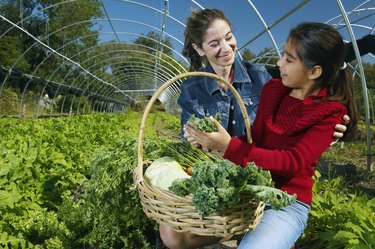
Organic foods are grown without chemical pesticides on farmland that is free of chemicals. The United States Department of Agriculture oversees the National Organic Program, which regulates organic farming standards in accordance with the Organic Foods Production Act of 1990. Organic meats come from organically managed livestock that are not fed slaughter by-products, steroids or antibiotics and feed off pastures, hay and grain concentrates. Organic dairy products come from organic farms and are chemical free.
Fruits & Vegetables
Video of the Day
Organic fruits and vegetables do not look as perfect as produce that has been farmed using chemical pesticides to kill all the parasites and bugs that feed on the plants. Organic fruits may have wormholes or other imperfections, but they are chemical and pesticide free.
Video of the Day
In order for fruits and vegetables to meet the United States Department of Agriculture's (USDA) organic standards, they must meet specific requirements for each type of crop or product. Organic crops are grown on land that is free of prohibited substances (chemicals) for at lease three years.
All produce have varying production requirements such as seed sources, soil fertility, planting, irrigation, pest management, diseases, nematodes, viruses, weeds, harvest and storage, according to the National Sustainable Agriculture Information Service.
Meats & Dairy
Every year there are cases of sporadic Creutzfeld-Jakob disease, also known as mad cow disease in the United States, according to the Minnesota Institute for Sustainable Agriculture (MISA). Eating organic beef, chicken, pork and other meats is a healthier option.
The USDA regulates how organic meat and dairy are classified and regulated. In 2010, the Agriculture Department narrowed the definition of what is considered organic meat, according to the February 13, 2010, San Francisco Chronicle. In 1977, the FDA banned feeding cattle blood, poultry litter, human food wastes, brain and spinal tissue.
All organic livestock operations must maintain records to prove the identity of all organically managed livestock, according to the National Organic Program. This means all organic livestock are tracked from birth to slaughter. The feed mills must be inspected and certified. Organic feed cannot contain antibiotics, hormones, slaughter by-products, insecticides and rodenticides, according to MISA. Organic livestock can only be slaughtered in certified organic slaughterhouses. Most importantly, organic livestock must be fed and managed organically their entire lives to be certified organic.
Pet Food
Organic pet food is subject to the same standards as produce and meats. In order to put the USDA organic label on pet food products, the product must be produced by certified organic operations, according to the University of Minnesota. Pet food producers must seek certification to display the "USDA Organic" logo on their products. The National Organic Program and the USDA regulate organic pet food.
Baby Foods
Organic baby foods are made with certified organic ingredients regulated by the USDA and the National Organic Program. While these products are certified organic, some use ingredients that have been questioned by pediatricians. An article in the May 19, 2008, New York Times noted that a popular organic baby product, Similac Organic formula, is sweetened with cane sugar or sucrose. While these ingredients are considered safe and approved by the USDA, some pediatricians worry that the sweetened formula can harm tooth enamel and lead to rapid weight gain.
- Environmental Protection Agency: Organic Farming
- United States Agricultural Department: National Organic Program
- National Sustainable Agriculture Information Service: Organic Farming
- Organic Mall: Organic Products
- San Francisco Chronicle: SFGate: Clearer Definition of 'Organic' Meat, Milk
- New York Times: For an All-Organic Formula, Baby, That's Sweet